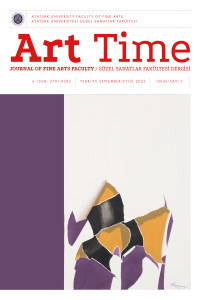Kırsalda Başkent Üslubu Örneği: Koçarlı Cihanoğlu Mustafa Ağa Camii Duvar Resmi Süslemeleri
Cihanoğulları Principality, which established its dominance in Aydın, one of the important "Ayanlik" centers of the Aegean Region; They built many architectural works in the surrounding villages and settlements, especially in Aydın Güzelhisarı, and they decorated these works with various depictions according to the characteristics of the period. The mosque, which is named after Cihanzade Mustafa Ağa, is located in the center of Koçarlı district, an important center of the Cihanoğulları principality. The interior architecture and decoration of the building, which has been rebuilt and repaired several times, has beautiful examples to arouse admiration. Although it is an example of a provincial building, it looks like a capital city with its use of high quality materials and workmanship, original and multicolored wall paintings. In this study, the wall paintings of the Cihanzade Mustafa Ağa Mosque, whose history can be traced back to 1612M; The techniques of making the depictions, the content of the subject and their place in the Ottoman architectural decorations were examined.
Anahtar Kelimeler:
Art of History, Cihanzade Mustafa Ağa Mosque, Vall Paintings, Depictions, Architecture and Decoration
A Capital Style Example in The Rural: Koçarli Cihanoğlu Mustafa Ağa Mosque Mural Painting Decorations
Cihanoğulları Principality, which established its dominance in Aydın, one of the important "Ayanlik" centers of the Aegean Region; They built many architectural works in the surrounding villages and settlements, especially in Aydın Güzelhisarı, and they decorated these works with various depictions according to the characteristics of the period. The mosque, which is named after Cihanzade Mustafa Ağa, is located in the center of Koçarlı district, an important center of the Cihanoğulları principality. The interior architecture and decoration of the building, which has been rebuilt and repaired several times, has beautiful examples to arouse admiration. Although it is an example of a provincial building, it looks like a capital city with its use of high quality materials and workmanship, original and multicolored wall paintings. In this study, the wall paintings of the Cihanzade Mustafa Ağa Mosque, whose history can be traced back to 1612M; The techniques of making the depictions, the content of the subject and their place in the Ottoman architectural decorations were examined.
Keywords:
Art of History, Cihanzade Mustafa Ağa Mosque, Vall Paintings, Architecture and Decoration, Depictions,
___
- Algaç, Ş. (2020). Uşak/ Banaz-Yeşilyurt (Holuz) Köyü Camii ve kalemişi bezemeleri. Art-Sanat Dergisi, S. 13, 1-26.
- Altınay, A. R. (1973). Lale Devri. Başbakanlık kültür müsteşarlığı.
- Arel, A. (1990). Ege bölgesi Ayanlık dönemi mimarisi 1989 dönemi yüzey araştırmaları. VIII. Araştırma sonuçları toplantısı, 1-29.
- Arel, A. (1988). Aydın ve yöresinde bir Ayan ailesi ve mimarlık: Cihanoğulları. Osmanlı’dan Cumhuriyete problemler, araştırmalar, tartışmalar sempozyumu. I. Uluslararası Tarih Kongresi Bildirileri, 184-221.
- Arık, R. (1988). Batılılaşma dönemi Anadolu tasvir sanatı. Kültür ve Turizm Bakanlığı. Berkli, Y. (2010). Uygur resim sanatının üslup özellikleri. Atatürk Üniversitesi Edebiyat Fakültesi Dergisi, S. 10, 155–166.
- Demirarslan, D. (2016). 19. yüzyıl Osmanlı dini mimarisinde duvar resmi sanatı: Balkanlardan Kalkandelen Alaca Camii örneği. Türk Kültürü ve Hacı Bektaşi Veli Araştırma Dergisi, S.80, 151-182.
- Ersoy, İ. K. (2019). Batı Anadolu’dan adalara duvar resmi bağlamında Midilli’de resimli iki konut. Sanat Tarihi Dergisi, S. XXVIII, 165-191.
- Eyice, S. (1992). Batılılaşma. DİA, C.5, 171-181.
- Gürsoy, E. (2015). Uşak’ta perde motifli mihraplar. ASOS Journal Dergisi, S. 10, 146-157.
- İnci, N. (1985). 18. yüzyılda İstanbul camilerine batılılaşmayla gelen yenilikler.
- İrepoğlu, G. (1993). Osmanlı minyatür sanatında Klasik Dönem. Türk Kültüründe Sanat ve Mimari, S.I, 73-87.
- İerpoğlu, G. (1999). Lale devrinin “Çelebi” Nakkaşı Levni. Sanat Dünyamız, S. 73, 235-243.
- Kuyulu, İ. (1988). Geç dönem Anadolu tasvir sanatından yeni bir örnek: Soma Damgacı Camii. Sanat Tarihi Dergisi, C.4, S.4, 67-85.
- Kuyulu, İ. (1994). Ödemiş Bademli Kılcızade Mehmet Ağa Camisi (Ödemiş/İzmir). Vakıflar Dergisi, S. XXIV, 147-158.
- Karal, E. Z. (1940). Halet Efendinin Paris büyük elçiliği. İstanbul Üniversitesi Yayınları No. 102.
- Kuban, D. (1954). Türk Barok mimarisi hakkında bir deneme.
- Mantran, R. (1962). Osmanlı İmparatorluğu tarihi. (Çev. Server Tanilli), Yapı Kredi Yayınları, C.2.
- Naldan, F. (2019). Geç Dönem Kalemişi Süslemelerine Yeni Bir Örnek: Kemaliye Orta Camii. ERDEM Dergisi, S. 76, 185-204.
- Pardoe, J. (2010). Sultanlar Şehri İstanbul. (Çev. M. Banu Büyükkal), İş Bankası Yayını.
- Renda, G. (1977). Batılılaşma Döneminde Türk resim Sanatı 1700-1850.
- Tali, Ş. (2017). Kırşehir Mucur’daki Hüseyin Ağa Camiiile Emine Hanım Camii’nin kalemişleri. Uluslararası Sosyal Araştırmalar Dergisi: Hamza Gündoğdu Armağanı, C.6, S. 25, 504- 528.
- Tanman, B. (1993). Çakırağa konağı. DİA, C8, 188-189.
- Tansuğ, S. (2004). Resim Sanatının Tarihi. Remzi Kitapevi.
- Başlangıç: 2021
- Yayıncı: Atatürk Üniversitesi
